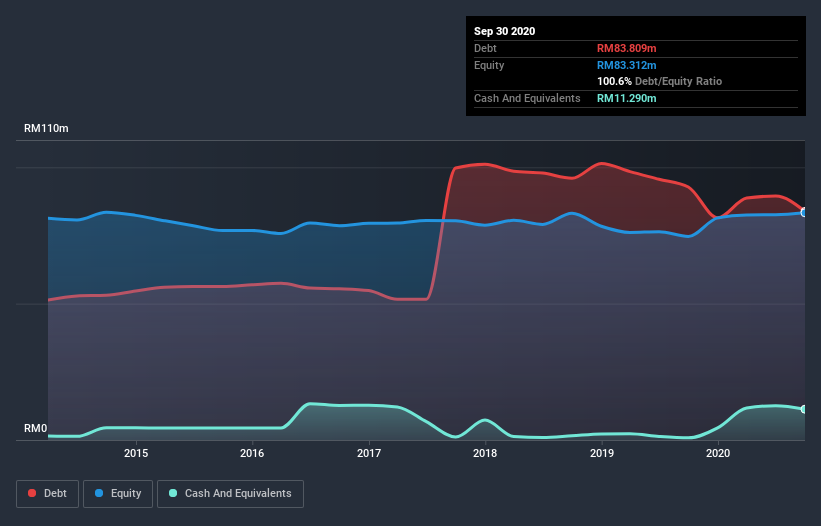Is Sin Heng Chan (Malaya) Berhad (KLSE:SHCHAN) Using Too Much Debt?

Warren Buffett famously said, 'Volatility is far from synonymous with risk.' So it seems the smart money knows that debt - which is usually involved in bankruptcies - is a very important factor, when you assess how risky a company is. We note that Sin Heng Chan (Malaya) Berhad (KLSE:SHCHAN) does have debt on its balance sheet. But should shareholders be worried about its use of debt?
What Risk Does Debt Bring?
Debt and other liabilities become risky for a business when it cannot easily fulfill those obligations, either with free cash flow or by raising capital at an attractive price. Part and parcel of capitalism is the process of 'creative destruction' where failed businesses are mercilessly liquidated by their bankers. While that is not too common, we often do see indebted companies permanently diluting shareholders because lenders force them to raise capital at a distressed price. Of course, debt can be an important tool in businesses, particularly capital heavy businesses. When we think about a company's use of debt, we first look at cash and debt together.
Check out our latest analysis for Sin Heng Chan (Malaya) Berhad
What Is Sin Heng Chan (Malaya) Berhad's Debt?
The image below, which you can click on for greater detail, shows that Sin Heng Chan (Malaya) Berhad had debt of RM83.8m at the end of September 2020, a reduction from RM92.8m over a year. However, because it has a cash reserve of RM11.3m, its net debt is less, at about RM72.5m.

A Look At Sin Heng Chan (Malaya) Berhad's Liabilities
According to the last reported balance sheet, Sin Heng Chan (Malaya) Berhad had liabilities of RM42.1m due within 12 months, and liabilities of RM66.2m due beyond 12 months. On the other hand, it had cash of RM11.3m and RM7.37m worth of receivables due within a year. So its liabilities outweigh the sum of its cash and (near-term) receivables by RM89.6m.
When you consider that this deficiency exceeds the company's RM64.0m market capitalization, you might well be inclined to review the balance sheet intently. In the scenario where the company had to clean up its balance sheet quickly, it seems likely shareholders would suffer extensive dilution.
We use two main ratios to inform us about debt levels relative to earnings. The first is net debt divided by earnings before interest, tax, depreciation, and amortization (EBITDA), while the second is how many times its earnings before interest and tax (EBIT) covers its interest expense (or its interest cover, for short). This way, we consider both the absolute quantum of the debt, as well as the interest rates paid on it.
Sin Heng Chan (Malaya) Berhad has a debt to EBITDA ratio of 3.3 and its EBIT covered its interest expense 3.3 times. Taken together this implies that, while we wouldn't want to see debt levels rise, we think it can handle its current leverage. One redeeming factor for Sin Heng Chan (Malaya) Berhad is that it turned last year's EBIT loss into a gain of RM16m, over the last twelve months. The balance sheet is clearly the area to focus on when you are analysing debt. But it is Sin Heng Chan (Malaya) Berhad's earnings that will influence how the balance sheet holds up in the future. So when considering debt, it's definitely worth looking at the earnings trend. Click here for an interactive snapshot.
Finally, while the tax-man may adore accounting profits, lenders only accept cold hard cash. So it is important to check how much of its earnings before interest and tax (EBIT) converts to actual free cash flow. Over the most recent year, Sin Heng Chan (Malaya) Berhad recorded free cash flow worth 53% of its EBIT, which is around normal, given free cash flow excludes interest and tax. This cold hard cash means it can reduce its debt when it wants to.
Our View
We'd go so far as to say Sin Heng Chan (Malaya) Berhad's level of total liabilities was disappointing. But on the bright side, its conversion of EBIT to free cash flow is a good sign, and makes us more optimistic. Looking at the bigger picture, it seems clear to us that Sin Heng Chan (Malaya) Berhad's use of debt is creating risks for the company. If all goes well, that should boost returns, but on the flip side, the risk of permanent capital loss is elevated by the debt. There's no doubt that we learn most about debt from the balance sheet. But ultimately, every company can contain risks that exist outside of the balance sheet. Be aware that Sin Heng Chan (Malaya) Berhad is showing 3 warning signs in our investment analysis , and 1 of those can't be ignored...
When all is said and done, sometimes its easier to focus on companies that don't even need debt. Readers can access a list of growth stocks with zero net debt 100% free, right now.
When trading Sin Heng Chan (Malaya) Berhad or any other investment, use the platform considered by many to be the Professional's Gateway to the Worlds Market, Interactive Brokers. You get the lowest-cost* trading on stocks, options, futures, forex, bonds and funds worldwide from a single integrated account. Promoted
New: Manage All Your Stock Portfolios in One Place
We've created the ultimate portfolio companion for stock investors, and it's free.
• Connect an unlimited number of Portfolios and see your total in one currency
• Be alerted to new Warning Signs or Risks via email or mobile
• Track the Fair Value of your stocks
This article by Simply Wall St is general in nature. It does not constitute a recommendation to buy or sell any stock, and does not take account of your objectives, or your financial situation. We aim to bring you long-term focused analysis driven by fundamental data. Note that our analysis may not factor in the latest price-sensitive company announcements or qualitative material. Simply Wall St has no position in any stocks mentioned.
*Interactive Brokers Rated Lowest Cost Broker by StockBrokers.com Annual Online Review 2020
Have feedback on this article? Concerned about the content? Get in touch with us directly. Alternatively, email editorial-team (at) simplywallst.com.
About KLSE:SHCHAN
Sin Heng Chan (Malaya) Berhad
An investment holding company, operates oil palm plantations in Malaysia.
Slight with acceptable track record.
Market Insights
Community Narratives



